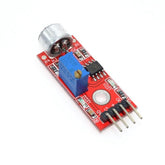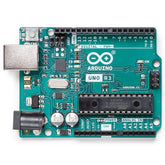Sound Sensor Working and Its Applications
Summary
If you're interested in learning about sound sensors and their applications, then this blog is perfect for you! In this informative article, you'll discover the working principle of sound sensors, their features, and how they can be interfaced with an Arduino board. Whether you're a beginner or an experienced hobbyist, this blog will provide you with valuable insights into the world of sound sensors. Get ready to dive into the exciting world of sound sensing technology!
Introduction
A sound sensor is a device capable of detecting the presence and intensity of audio signals in its environment. It can be used to measure or detect anything that has associated waves with it, such as noise levels, vibration frequencies, echoes from ultrasound applications etc. Sound sensors are widely employed for various industrial purposes like monitoring machinery vibrations & noises generated by them; analyzing acoustic emission generated due to fatigue failure on machine elements when equipment’s running at high speeds.
Furthermore these devices provide data input into Industrial Automation Systems which allow machines / robots execute tasks according to specific rules depending on corresponding parameters acquired through said detection components leading toward more effective control over operations under different environmental conditions while increasing safety protocols significantly!
Sound sensors are electronic devices that are used to detect and measure sound waves. They are widely used in a variety of applications, including sound recording, noise measurement, and speech recognition. In this blog post, we will discuss the working principle, features, and applications of sound sensors.
What is a Sound Sensor?
A sound sensor is a device that converts sound waves into an electrical signal that can be processed by an electronic circuit. They can be used to detect and measure the amplitude, frequency, and duration of sound waves. Sound sensors are available in a variety of different types, including microphones, piezoelectric sensors, and condenser microphones.

Sound Sensor Pin Configuration
The pin configuration of a sound sensor typically includes an input pin, an output pin, and a power supply pin. The input pin is used to receive sound waves, the output pin is used to send the electrical signal to an electronic circuit, and the power supply pin is used to provide power to the sensor. Some sound sensor has 4 pins, that has an additional pin for Analog output which can give in a precise variation of the sound in the surrounding.
- Vcc – 3.3V to 5V.
- GND – Ground.
- Out – to any Digital pin in the microcontroller.
Sound sensor and Arduino interfacing:

Here, let us consider the sound sensor is connected to Arduino UNO. The OUT terminal of the sensor is connected to Digital pin 8 of Arduino, so whenever the microphone detects a sound signal that is greater than the threshold value (threshold value can be set by tuning the potentiometer), the sensor gives a HIGH pulse. There is a sound sensor that has Analog output pins which could precisely detect the sound level in the surrounding instead of just the HIGH and LOW pulse value given by this sensor.
Working Principle
The working principle of a sound sensor is based on the conversion of sound waves into an electrical signal. When sound waves strike a microphone, for example, they cause the diaphragm to vibrate. This vibration generates an electrical signal that is proportional to the amplitude of the sound waves. This electrical signal is then sent to an electronic circuit for processing.
This sensor's operation is based on the same principles as human hearing. Because the human eye has a diaphragm, which employs vibrations to transform into messages as its primary function, in contrast, this sensor makes use of a microphone, whose primary purpose is to convert vibrations into current or voltage, as appropriate.
Typically, it has a diaphragm made of magnets that have been wound around a metal wire. Magnets inside the sensor vibrate in response to sound impulses, and current can also be stimulated from the coils at the same time.
Features
- High sensitivity
- Low noise
- High signal-to-noise ratio
- High-frequency response
- Low distortion
- High dynamic range
- Compact size
Specifications
- The operational voltage range is 3.3 to 5 V.
- 4–5 mA is the operational current.
- 26 dB of voltage gain ((V=6V, f=1kHz))
- 52 to 48 dB is the microphone's (1kHz) sensitivity range.
- The microphone has a 2.2k Ohm impedance.
- The microphone's frequency ranges from 16 to 20 kHz.
- The ratio of the signal to noise is 54 dB.
Applications
- Sound recording: Sound sensors are commonly used in sound recording equipment, such as microphones and audio recorders, to capture sound waves and convert them into electrical signals.
- Noise measurement: Sound sensors are used in noise measurement equipment, such as sound level meters, to measure the amplitude and frequency of sound waves and to calculate the decibel level of the sound.
- Speech recognition: Sound sensors are used in speech recognition systems to capture and process the sound of speech.
- Security systems: Sound sensors are used in security systems to detect the presence of sound and to trigger an alarm if a sound is detected.
- Robotics: Sound sensors are used in robotics to detect and respond to sound to navigate, communicate, or avoid obstacles.
Conclusion
A sound sensor is a powerful tool for detecting and measuring sound levels in various applications. When combined with Arduino, it becomes a versatile and cost-effective solution for audio-related projects. By understanding its working principle and features, you can unleash the full potential of sound sensors in your projects. Whether you're a hobbyist or a professional, sound sensors can help you achieve your goals with ease. So, don't hesitate to explore the exciting world of sound sensors and Arduino interfacing and let your creativity soar!
If you appreciate our work don't forget to share this post and leave your opinion in the comment box.
Please do check out other blog posts about Popular electronics
Make sure you check out our wide range of products and collections (we offer some exciting deals!)
Frequently Asked Questions
1. What is the use of sound sensor in IOT?
A sound sensor detects sound waves and converts them into electrical signals. It combines a microphone and processing circuitry on a small board. It measures sound intensity and produces a digital output signal using a microphone and LM393 level comparator chip. The sensor is commonly used in applications like switches, security systems, monitoring, and speech recognition software. It can be interfaced with Arduino or other microcontrollers for creating sound-responsive IoT devices.
2. How do sound sensors work?
The sound sensor operates in a similar way to the human ear, utilizing a diaphragm that transforms air pressure vibrations into electrical signals.
Comprising a microphone for detecting the sound source, an audio power amplifier, and a peak detector, the sound sensor is designed.
The microphone within the sound sensor captures sound signals and converts them into an output voltage signal on a microcontroller.
Subsequently, the microcontroller processes the sound. The sensitivity of the sound sensor is sufficient to detect sound levels that can be discerned by the human ear. The sound sensor's board interface is a compact board that combines a microphone and processing circuitry, enabling the conversion of sound waves into electrical signals.
3. Is sound sensor active or passive?
Sound sensors can operate in either an active or passive manner, depending on their functionality. An active sensor involves emitting a signal into the surroundings and then measuring the resulting response. For instance, an ultrasonic sensor actively transmits sound waves and calculates the time it takes for them to bounce back to the sensor.
On the other hand, a passive sensor detects natural radiation or emissions originating from the target or the environment. A microphone serves as a passive sound sensor by detecting sound waves in the environment and converting them into an electrical signal.
Therefore, whether a sound sensor is classified as active or passive hinges on whether it emits a signal or detects natural radiation or emissions.
Comprising a microphone for detecting the sound source, an audio power amplifier, and a peak detector, the sound sensor is designed.
The microphone within the sound sensor captures sound signals and converts them into an output voltage signal on a microcontroller.
Subsequently, the microcontroller processes the sound. The sensitivity of the sound sensor is sufficient to detect sound levels that can be discerned by the human ear. The sound sensor's board interface is a compact board that combines a microphone and processing circuitry, enabling the conversion of sound waves into electrical signals.






